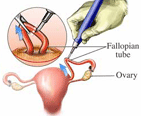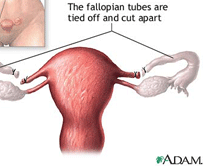 There is a variety of birth control methods that protect against unexpected pregnancy. However, if a woman wants a permanent birth control , there is only one choice — tubal ligation. It is very suitable for couples, who for some reason are not planning to have more children. Permanent female sterilization is a safe, effective and permanent method of birth control. Therefore, it is vital to consider all the pros and cons before the procedure, since tubal ligation reversal is possible but very expensive, complicated, and has a relatively low rate of success.
There is a variety of birth control methods that protect against unexpected pregnancy. However, if a woman wants a permanent birth control , there is only one choice — tubal ligation. It is very suitable for couples, who for some reason are not planning to have more children. Permanent female sterilization is a safe, effective and permanent method of birth control. Therefore, it is vital to consider all the pros and cons before the procedure, since tubal ligation reversal is possible but very expensive, complicated, and has a relatively low rate of success.
What is it?
Tubal ligation is a surgical procedure during which the fallopian tubes are cut and sealed in order to make it impossible for the egg to travel down from the tubes to the uterus. It also stops sperm from entering the uterus and the egg and sperm cannot meet each other, hence, fertilization cannot happen. It is a female sterilization method and permanent mean of contraception .
This surgical procedure is highly effective immediately and has the efficiency rate in contraception of 99.5%.
How it works
Each ovary produces an egg every second month. The fallopian tubes carry this egg from the ovaries to the uterus every month and, if it meets sperm, a woman is able to conceive. During tubal ligation each of the fallopian tubes is cut and sealed with rings, bands, clips, or seared with a caustic. An egg then cannot reach the uterus and sperm is prevented from reaching an egg, and hence fertilization cannot occur.
Surgical procedure
 Tubal ligation is a minor surgical procedure that is usually performed in an inpatient or outpatient department. If a woman is suitable for the procedure, it can be performed when a patient is sure that she is not pregnant. Female fertilization can be performed under general or local anesthesia.
Tubal ligation is a minor surgical procedure that is usually performed in an inpatient or outpatient department. If a woman is suitable for the procedure, it can be performed when a patient is sure that she is not pregnant. Female fertilization can be performed under general or local anesthesia.
Most of tubal ligation procedures are performed through endoscopic surgery. This allows a minimally invasive intervention and takes a shorter time to recover afterwards. It involves a small incision close to the navel through which a thin endoscopic camera is inserted. Another incision is made above the pubic hairline through which a surgical endoscopic instrument, that can cut and seal the tubes, is inserted. It takes about half an hour for the surgery to be complete.
A patient is advised to take two or three days off. She is also recommended reduce physical activities and exercise for more than a week. Sexual activities are allowed once a woman feels comfortable, generally, after a week. If surgery was performed through vagina, a patient is told not to insert anything into the vagina for at least two weeks in order to avoid infection.
Some women decide to have tubal ligation performed straight after pregnancy and childbirth. It is very convenient, since a woman is already in the hospital and this procedure does not prolong hospital stay after childbirth. If a woman has a Caesarean section performed, it is very easy for a gynecologist to cut the fallopian tubes through the same procedure.
Therefore if you decide to be sterilized after pregnancy, talk to your doctor and inform him/her about your decision prior to the childbirth.
Cost of tubal ligation
The cost of tubal ligation usually ranges from $1,200 to $6,000. It depends very much upon the state, region and private clinic. Some insurance providers cover at least part of the surgery cost, therefore, you should check with your insurance for more information.
An average price of tubal ligation:
| New York | $4.500 |
| California | $3.400 |
| Texas | $2.500 |
| Tennesse | $2.500 |
| Massachusetts | $4.400 |
| Florida | $3.900 |